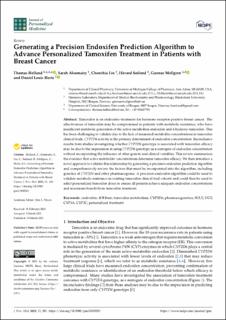| dc.contributor.author | Helland, Thomas | |
| dc.contributor.author | Alsomairy, Sarah | |
| dc.contributor.author | Lin, Chenchia | |
| dc.contributor.author | Søiland, Håvard | |
| dc.contributor.author | Mellgren, Gunnar | |
| dc.contributor.author | Hertz, Daniel Louis | |
| dc.date.accessioned | 2022-04-20T07:01:00Z | |
| dc.date.available | 2022-04-20T07:01:00Z | |
| dc.date.created | 2021-04-20T10:44:07Z | |
| dc.date.issued | 2021 | |
| dc.identifier.uri | https://hdl.handle.net/11250/2991425 | |
| dc.description.abstract | Tamoxifen is an endocrine treatment for hormone receptor positive breast cancer. The effectiveness of tamoxifen may be compromised in patients with metabolic resistance, who have insufficient metabolic generation of the active metabolites endoxifen and 4-hydroxy-tamoxifen. This has been challenging to validate due to the lack of measured metabolite concentrations in tamoxifen clinical trials. CYP2D6 activity is the primary determinant of endoxifen concentration. Inconclusive results from studies investigating whether CYP2D6 genotype is associated with tamoxifen efficacy may be due to the imprecision in using CYP2D6 genotype as a surrogate of endoxifen concentration without incorporating the influence of other genetic and clinical variables. This review summarizes the evidence that active metabolite concentrations determine tamoxifen efficacy. We then introduce a novel approach to validate this relationship by generating a precision endoxifen prediction algorithm and comprehensively review the factors that must be incorporated into the algorithm, including genetics of CYP2D6 and other pharmacogenes. A precision endoxifen algorithm could be used to validate metabolic resistance in existing tamoxifen clinical trial cohorts and could then be used to select personalized tamoxifen doses to ensure all patients achieve adequate endoxifen concentrations and maximum benefit from tamoxifen treatment. | en_US |
| dc.language.iso | eng | en_US |
| dc.publisher | MDPI | en_US |
| dc.rights | Navngivelse 4.0 Internasjonal | * |
| dc.rights.uri | http://creativecommons.org/licenses/by/4.0/deed.no | * |
| dc.title | Generating a Precision Endoxifen Prediction Algorithm to Advance Personalized Tamoxifen Treatment in Patients with Breast Cancer | en_US |
| dc.type | Journal article | en_US |
| dc.type | Peer reviewed | en_US |
| dc.description.version | publishedVersion | en_US |
| dc.rights.holder | Copyright 2021 by the authors | en_US |
| dc.source.articlenumber | 203 | en_US |
| cristin.ispublished | true | |
| cristin.fulltext | original | |
| cristin.qualitycode | 1 | |
| dc.identifier.doi | 10.3390/jpm11030201 | |
| dc.identifier.cristin | 1905240 | |
| dc.source.journal | Journal of Personalized Medicine | en_US |
| dc.identifier.citation | Journal of Personalized Medicine. 2021, 11 (3), 201. | en_US |
| dc.source.volume | 11 | en_US |
| dc.source.issue | 3 | en_US |

